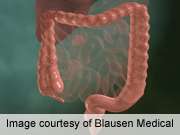A clinical pathway combining the Samuel's pediatric appendicitis score and selective use of ultrasonography has high sensitivity and specificity for diagnosing appendicitis in children, according to a study published online Dec. 30 in Pediatrics.
(HealthDay)—A clinical pathway combining the Samuel's pediatric appendicitis score (PAS) and selective use of ultrasonography (US) has high sensitivity and specificity for diagnosing appendicitis in children, according to a study published online Dec. 30 in Pediatrics.
Ashley Saucier, M.D., from the University of Tennessee Health Science Center in Memphis, and colleagues conducted a prospective observational cohort study involving 196 patients to assess the diagnostic accuracy of a clinical pathway for suspected appendicitis. Based on initial assessment, patients were determined to be at low (PAS 1 to 3), intermediate (PAS 4 to 7), or high (PAS 8 to 10) risk for appendicitis. Patients at low risk were discharged with telephone follow-up; those at intermediate risk underwent US evaluation; and those at high risk received immediate surgical consultation.
The researchers found that 65 patients (33.2 percent) had appendicitis. A total of 65.3 percent of patients underwent US and 37.5 percent were positive. Surgical consultants requested an abdominal computed tomography scan for 6.6 percent of patients. Three of 68 patients had a negative appendectomy (4.4 percent). Based on follow-up of 96.9 percent of patients, overall diagnostic accuracy of the pathway was 94 percent, with sensitivity and specificity of 92.3 and 94.7 percent, respectively. The positive likelihood ratio was 17.3 and the negative likelihood ratio was 0.08.
"Our study suggests that a clinical pathway combining PAS and US for use in children with suspected appendicitis presenting to our pediatric emergency department demonstrates higher sensitivity and specificity than using the PAS alone," the authors write.
More information:
Abstract
Full Text
Journal information: Pediatrics
Copyright © 2014 HealthDay. All rights reserved.




















